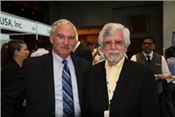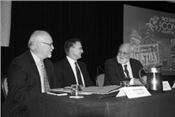|
Rice Around The World
Conference Brings World Rice Leaders Together In Houston
BETTY VALLE GEGG-NAEGER
MidAmerica Farmer Grower
HOUSTON, TEXAS
The Rice Market And Technology Conference held recently in Houston, drew some 450 people affiliated in all areas of the rice industry from 35 different countries throughout the world.
The event is sponsored yearly by the US Rice Producers Association (USRPA) led by Dwight Roberts, CEO of USRPA.
“The US Rice Producers started this conference several years ago. We’re real excited about having it in Houston, Texas, for the first time,” he said.
Roberts and the USRPA have been involved in the conference for 10 years with a partnership, but have been doing it totally in house since 2011. The traveling conference was held in Mexico last year, in Costa Rica prior to that, and it’s been in Panama, Cartagena, even in Brazil back in 2008. It’s was held in Miami several times, and this year in Houston.
The conference has grown significantly during those years.
“We like the size of it now,” Roberts said. “If we get much bigger than this, we would have to go to a convention center and we really like the comradery that a hotel gives to everyone because the networking is so important. We have over 260 companies registered this year, it’s a ‘who’s who’ of rice companies in the western hemisphere, representing all of the major players.”
The eastern part of the world also was well represented with businesses from Singapore, Myanmar, Taiwan, India, Pakistan and a company from China. Those attending from foreign countries represent producers, millers, market analysts and equipment companies. People from the Mercosur countries that were in attendance own the mills and also their own large farm acreages of rice.
“Rice mills from Argentina, Brazil, Paraguay and Uruguay process some 16 million tons of paddy rice per year, 40 percent or more of the rice in the Americas; and they influence our prices so their attendance at the conference gives us a great opportunity to understand their issues and production numbers,” said Roberts.
While milling and marketing are significant issues, there’s also a lot of focus on seed technology. Issues like what the seed of tomorrow will look like, whether it will serve consumer’s needs, whether the industry is dealing with grain quality issues well enough and what the consumer wants are also important topics. The conference provided something for everyone, from the farm to the dinner table. This visit to the United States attracted interest even before the conference started.
“There were many people who have been here visiting before the conference started, and a group of Peruvians flew in, rented a van and drove to Arkansas to visit a new rice mill,” he reported. “Others plan to visit research stations or equipment companies like Sataki, and Delta technologies, and some will go to Louisiana and see what a crawfish farm is all about, as well as visit the port, rail facility and farms in Louisiana.
“They’re especially interested in the port facility; of course, the folks from Mexico are always interested in the rail issues,” said Roberts. “That’s our purpose as US Rice Producers; we want to bring the buyers here, we also get to see what our competition is doing. It gives us a little bit of a heads up on a lot of different things so we can have a little better understanding of the changes going on in, say, Columbia or Peru, Central America, that are so important. We have a great line-up of speakers here this year and there’s definitely something for everyone.”
With world representation, there’s a need for language translations.
“We do simultaneous translations in three languages, Portuguese and Spanish as well as English,” Roberts said. “We started this conference for the western hemisphere for the most important markets for long grain rice and so those are the three languages that we focus on. It’s a great tool to use.”
The attendees simply have to ‘put on their ears.’
“We have simultaneous translators,” he said. “If you don’t speak the language you put on the audio phone, the ear phone that they recommend and then it can go in any direction you need, English to Spanish, Portuguese to Spanish, Spanish to Portuguese, whatever way you need it. It’s an expensive tool, but it’s very important; you can’t run an international conference without it.”
Roberts feels the conference in Houston opens the potential for extra sales from the United States.
“I was very pleased to hear the comment from a fellow from Argentina who told me that people like American farmers. They want to talk to American farmers, visit American farmers and they really hold the U.S. farmer at a really high level of expertise. I think that’s a really big advantage for us, as our farmers are accommodating and like to show how they farm rice and how they take care of their rice and I think that’s a huge benefit for us in selling rice.”
Slightly over 260 companies registered for the conference, and all of the big players were in attendance.
“The Bunges, the Dreyfuses, the ADMs, the Eurocoms, all the big traders were there,” Roberts said. “Jackson and sons out of the United Kingdom, one of the largest rice brokers in the world, attends each year.”
The site for next year’s conference was not yet decided, but Roberts likes Miami, primarily because “it’s very close to the United States.”
“I know that’s a joke, but you know every free country has a direct flight to Miami from Latin America,” he said. “They know the city, language is not an issue. It’s been three years since we were in Miami the last time. Everyone from Latin America likes Miami, so I joke that ‘it’s very close to the United States,’ which means it is a crossroads. It’s a great place to have a conference, a lot of the Latin Americans have relatives there or they went to school there, or their doctors are there or, they know the shopping, and language is not an issue. But we’re looking at some other sites too.”
As the conference opened, Roberts gave a glowing introduction for the keynote speaker, Robert Zeigler, who discussed “How Science Is Saving The World.”
“For a real treat, we have Dr. Robert Zeigler who managed for many years the world’s largest rice research institute in the Philippines,” Roberts said.
An internationally known and respected plant pathologist, Zeigler holds a Ph.D from Cornell University, Masters of Science from Oregon State University and has done undergraduate work at the University of Illinois and studied at Harvard Business School. He studied Corporate Management at Kellogg School of Management. He’s authored hundreds of articles in scientific journals, and is highly recognized around the world. Zeigler has received a long list of honors and awards.
“We are so happy that he and his schedule allowed him to come to Houston on this day and share his thoughts on how science is saving the world,” Roberts said.
Zeigler stressed the growth in rice demand that is expected to occur in the world in years to come.
“By 2040 there will be a significant demand for rice, but the problem is yield growth rates are not keeping up. We have to be increasingly aware the demand for rice remains strong and will continue,” he said.
“If we look at the technology changes that we enjoy, we have to make sure that the policy makers are on board also,” he stressed.
There’s a lot of new science coming down the pipeline to increase production in the world. The breakthrough came with the sequence of one-rice genome. This was a major breakthrough that was unimaginable 10-15 years ago. That brings a vast untapped resource and new rice genetics will be coming out because of it, the rate will be staggering. Already there are 120,000 varieties of rice.
“Another mind blowing development is the use of wild relatives of rice that look like weeds but are closely related to rice,” he noted. “They have a whole range of traits that rice doesn’t have. But we succeeded in building bridges to bring these traits into rice,” Zeigler announced. ∆
BETTY VALLE GEGG-NAEGER: Senior Staff Writer, MidAmerica Farmer Grower

Pictured with Michael Scuse (left), Acting Deputy Secretary of the USDA,
is Gary Murphy, a farmer from Bernie, Missouri who farms cotton, soybeans,
corn and rice.
Photo by John LaRose

Speaking at the Rice Market & Technology Convention in Houston recently were, from left: Dwight Roberts, President and CEO of
USRPA; Tommy Turner, Chairman of USRPA; and Robert Zeigler, Keynote Speaker at the conference, who discussed
how science is saving the world.
Photo by John LaRose
|
|